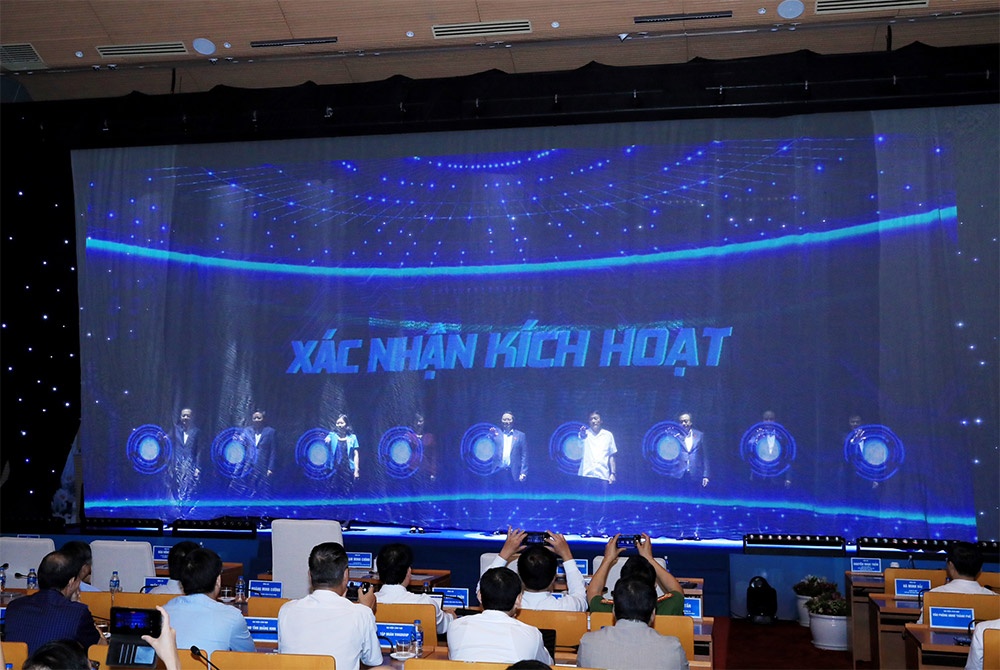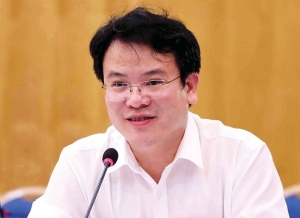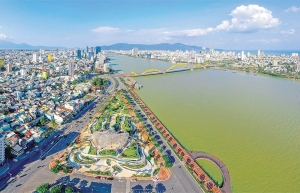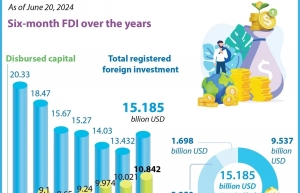Hanoi to expand IPs to welcome FDI
After receiving approval for operation of Phung Hiep Industrial Park (IP) in Thuong Tin district, Hoa Phu Invest JSC is completing procedures to prepare for construction. The project, which covers almost 175 hectares, has an investment of $122 million.
 |
| Hanoi unveils digital app to connect citizens and businesses with all levels of government |
The project is valid for 50 years and construction must be completed within 36 months from the date of land allocation or lease by the state.
Developing IPs and clusters is a major policy of Hanoi, according to Nguyen Manh Quyen, Vice Chairman of Hanoi People’s Committee, spoke at a press conference in late June. “Hanoi intends to build more IPs to attract foreign investment. The city will prioritise site clearance and accelerate the development of a comprehensive and modern infrastructure system,” he said.
“Moreover, relevant agencies will be instructed to improve the quality of investment promotion activities. Hanoi will conduct thorough audits to ensure that investors fully comply with the commitments made in their investment licences,” Quyen said.
Hanoi leaders have asked the Ministry of Planning and Investment to strengthen information sharing and continue to provide support, working closely with the capital to improve the effectiveness of attracting foreign investment.
At the same time, the city will organise implementation of 2022 regulations regulating the management of IPs and economic zones and a March 2024 decree on management and development of clusters, to help accelerate the progress of establishing new complexes in the area.
The city has plans to add nine IPs using over 2,900ha in the planning of the period from 2025-2030. Besides that, in the period, the city has plans to establish an additional 174 clusters.
Adding IPs and clusters in planning is necessary in the context that the current available land is filled, in collaboration with an increase in capital. According to Hanoi People’s Committee, the capital has 10 IPs across a total of 1,300ha, of which nine are fully occupied. The remainder are in the process of perfecting technical infrastructure.
In the first six months of 2024, foreign direct investment (FDI) flowing into Hanoi increased by 52 per cent over the same period last year, at $1.16 billion. There are 120 newly registered projects with worth just over $1 billion, 78 projects with a total additional registered capital of $55.21 million, and more than 100 capital contributions and share purchases with a value of $73.6 million.
By the end of the second quarter, Hanoi had just over 15,500 newly established enterprises worth $6.2 billion, a decrease of 3 per cent in the number of enterprises and the same ratio in registered capital compared to last year.
Hanoi aims to cultivate partnerships with key FDI markets, including South Korea, Singapore, Taiwan, the United States, Europe, Australia, and New Zealand.
In line with the Vietnamese government’s overarching strategy to boost investment promotion, Hanoi has undertaken comprehensive reforms aimed at attracting FDI across various sectors. The government’s focus is on high-added-value industries, such as manufacturing, logistics, tourism, education, healthcare, and clean energy.
To achieve this, Hanoi has set ambitious economic plans for key industries, with a particular emphasis on technology, construction projects, tourism, and urban development.
“To drive growth and achieve its investment targets, Hanoi seeks to attract up to $40 billion in FDI between 2021 and 2025, focusing on urban planning, clean water accessibility, and smart city initiatives,” Quyen said.
“Part of its strategy to achieve this will include tackling issues that hinder foreign investment, such as the slow development of IPs and clusters, high land rentals, and small-scale support industry. The city is also committed to addressing environmental challenges, such as air pollution, which could impact its attractiveness to investors if left unmitigated,” he added.
| Hanoi to spend over $55 billion on urban railways |
| Hanoi Department of Transport last week announced its master plan for investment for the capital’s urban railway system. The plan aims to develop a synchronous, modern urban railway system and restructure the capital’s transport modes sustainably, promoting the rate of public passenger transport to reach 50-55 per cent by 2035 and 65-70 per cent after 2035. Hanoi aims to complete around 97km of metro between now and 2030, with total expected capital needs during the period reaching more than $14.6 billion. In 2031-2035, the capital plans to complete 300km of metro. The total expected capital needs for that phase is nearly $22.6 billion. With this roadmap, Hanoi expects that after 2030, urban railways will handle 35-40 per cent of public passenger traffic, transporting 9.7-11.8 million trips around the clock. In phase three during 2036-2045, the city plans to complete investment in the construction of 200km of metro at a cost of $18.2 billion. Thus, Hanoi will need more than $55 billion to complete 600km of metro by 2045. Hanoi People’s Committee has set out the principles for building capital structure for each stage and each line. In particular, the routes being implemented based on official development assistance (ODA) will continue to be completed with the budget from this capital source, and the remaining routes will focus on prioritising investment with state budget capital. According to Hanoi Department of Transport, as a result of reviewing public investment capital sources including budget capital, bond loans, ODA, and other mobilised capital sources, Hanoi expects by 2035, about $28.56 billion will be prepared and more than $8.6 billion will be required from the state budget. |
| Revised Capital Law being implemented |
| The revised Capital Law from May, which includes specific policies to promote Hanoi’s breakthrough development towards green and smart directions, is one of the key objectives the capital will focus on implementing in the second half of 2024. According to Ha Minh Hai, Vice Chairman of Hanoi People’s Committee, the revised Capital Law focuses on solutions and timelines for implementing the 2021-2030 period planning, with a vision towards 2050, and adjusts the overall capital planning until 2045, with a vision towards 2065. This includes issuing standards and norms as a basis for implementing priority lists of construction projects, attracting domestic and foreign investors. It enhances policies for exploiting land resources, regulations on land allocation, leasing, land use conversion, compensation regulations, support, resettlement, and land collection. It also improves the mechanism for determining land prices, finance policy mechanisms, real estate market-related legal regulations, agricultural land management and use, and resolves longstanding issues related to land management and use. Additionally, Hanoi will prioritise the development of urban technical infrastructure, improve state management efficiency in planning, land, urban areas, and environmental protection, and accelerate the progress of key transportation infrastructure projects. The revised Capital Law also emphasises the development of culture and cultural industries, including building policies to attract experts, artists, and others, both domestically and internationally. |
| Investment capital in Hanoi up by 9.5 per cent |
| In the first six months of 2024, construction activities in Hanoi have been notable with a 9.5 per cent increase in investment capital development compared to the same period last year, attracting nearly $1.2 billion in foreign investment, according to Hanoi Statistics Office. Out of an investment of $8.7 million in Hanoi, foreign direct investment (FDI) increased by 5.3 per cent (reaching $60 million), state investment increased by 13.7 per cent (reaching $3.1 billion), and non-state investment increased by 7.5 per cent (reaching $4.9 million). Hanoi has attracted $1.16 billion in FDI. Among these, there were 120 newly registered projects with a capital of $1 billion, 78 additional projects with increased investment capital of $55 million, and just over 100 instances of foreign investors contributing capital or buying shares totalling $74 million. Hanoi has over 220 basic public projects under concentrated construction, including 155 transitional projects and 70 new projects started this year. In the transport sector alone, there are 58 projects, accounting for almost one-fifth of the capital’s plan. Hanoi Statistics Office also reported that the total import-export turnover of the capital in the first half of this year reached $28.6 billion, a 13.7 per cent increase compared to the same period last year. Export turnover reached $8.9 billion, and import turnover reached $19.7 billion. Domestic economic areas witnessed a 14.8 per cent increase, and areas with foreign investment recorded a 6.1 per cent increase. Major export sectors showing increased turnover included computers, electronics and components, vehicles and spare parts, machinery, equipment and spare parts, agricultural products, petroleum, wood and wooden products. Three out of 12 export groups saw decreased turnover compared to the same period, including textiles, footwear and leather products, phones, and components. Similarly, the import turnover of goods reached $19.7 billion. Domestic economic areas accounted for $16.4 billion, and areas with foreign investment reached $3.3 billion. Major imported items in the first six months of this year included machinery, equipment and spare parts, petroleum, computers, electronics and components, vehicles and spare parts, iron and steel, and other metals. |
 | Vietnam continues to see growth in FDI Deputy Minister of Planning and Investment Tran Quoc Phuong stated that numerous international financial organisations remain optimistic about Vietnam’s ability to attract foreign direct investment (FDI) in the second half of the year. |
 | Free trade zone becomes lever for FDI attraction in Danang The central city of Danang will have opportunities to draw in more investment following approval to establish a free trade zone, with pilot preferential mechanisms to woo high-tech projects. |
 | FDI inflow into Vietnam reaches nearly 15.2 billion USD Vietnam attracted nearly 15.2 billion USD in foreign direct investment (FDI) in the first six months of this year, a year-on-year increase of 13.1 per cent, according to the General Statistics Office. |
What the stars mean:
★ Poor ★ ★ Promising ★★★ Good ★★★★ Very good ★★★★★ Exceptional
Related Contents
Latest News
More News
- Strengthening supply chains through trade promotions and customs reform (December 24, 2025 | 14:00)
- PM orders investment model for North–South high-speed rail (December 22, 2025 | 17:43)
- LS Eco Energy to invest in Vietnam rare earth sector (December 22, 2025 | 17:31)
- Government moves to establish International Financial Centre (December 21, 2025 | 21:00)
- Vietnam's IFC to target global investment flows (December 21, 2025 | 18:00)
- Two national hospitals expand capacity with new facilities (December 20, 2025 | 09:00)
- Ha Tinh breaks ground on major Vingroup industrial and energy projects (December 19, 2025 | 18:24)
- EVN launches major power infrastructure projects nationwide (December 19, 2025 | 18:17)
- VAL inaugurates second production line to meet domestic animal feed demand (December 19, 2025 | 16:37)
- Sun Group pioneers urban tram system in Phu Quoc (December 19, 2025 | 15:00)

 Tag:
Tag:





















 Mobile Version
Mobile Version